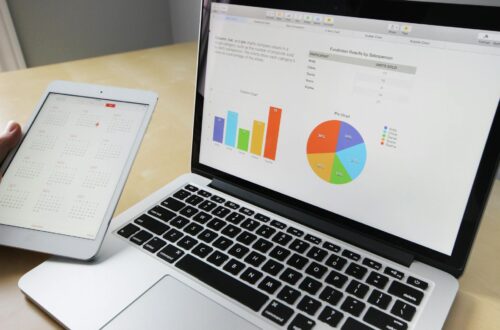In today’s data-driven business landscape, having the right data analytics tools is crucial for organizations looking to gain actionable insights and make informed decisions. As we move into 2024, the field of data analytics continues to evolve rapidly, with new technologies and capabilities emerging. This article will explore the top data analytics tools that every business should be aware of to stay competitive and leverage their data assets effectively.
Data analytics refers to the process of examining, cleaning, transforming, and modeling data to discover useful information, draw conclusions, and support decision-making. The benefits of robust data analytics for businesses include:
- Improved operational efficiency
- Enhanced customer understanding and targeting
- Data-driven product development
- More accurate forecasting and risk management
- Identification of new revenue opportunities
When evaluating data analytics tools, businesses should consider several key criteria:
- Ease of use and learning curve
- Scalability to handle growing data volumes
- Integration capabilities with existing systems
- Visualization and reporting features
- Advanced analytics capabilities (e.g. machine learning)
- Total cost of ownership
- Security and compliance features
With these factors in mind, let’s explore the must-have data analytics tools for businesses in 2024.
The Must-Have Data Analytics Tools

Python
Python has become the de facto standard programming language for data science and analytics. Its popularity stems from its versatility, extensive ecosystem of libraries, and relatively gentle learning curve.
Key strengths of Python for data analytics:
- Rich set of data manipulation and analysis libraries like Pandas and NumPy
- Powerful visualization tools such as Matplotlib and Seaborn
- Machine learning capabilities through scikit-learn
- Deep learning frameworks like TensorFlow and PyTorch
- Natural language processing with NLTK and spaCy
Python’s flexibility allows it to be used across the entire data analytics workflow – from data collection and cleaning to advanced modeling and deployment of analytics applications. Its open-source nature and vibrant community mean there’s a wealth of resources and packages available.
For businesses just getting started with Python, the Anaconda distribution provides a comprehensive set of data science tools and libraries in a single installable package. Jupyter Notebooks offer an interactive environment for exploratory data analysis and sharing of results.
While Python excels in many areas, it may not be the best choice for extremely large-scale data processing compared to distributed computing frameworks. However, for most business analytics needs, Python provides an excellent foundation.
R Programming
R remains a popular choice for statistical computing and graphics, particularly in academic and research settings. Many businesses leverage R for its statistical modeling capabilities and high-quality visualizations.
Key features of R for data analytics:
- Comprehensive statistical analysis functions
- Advanced data visualization through ggplot2
- Specialized packages for finance, bioinformatics, and other domains
- Reproducible research and reporting with R Markdown
- Integration with big data technologies like Spark
R’s strength lies in its statistical roots, making it ideal for complex statistical modeling and hypothesis testing. The tidyverse collection of packages, including dplyr and tidyr, provides powerful tools for data manipulation and analysis.
Compared to Python, R has a steeper learning curve for those without a statistical background. However, for organizations with statisticians or data scientists on staff, R can be an invaluable tool for in-depth analysis.
RStudio provides an integrated development environment (IDE) that makes working with R more accessible, especially for those transitioning from other analytics platforms.
SQL
Structured Query Language (SQL) remains a critical skill for data analysts, as much of the world’s data resides in relational databases. While not a full-fledged analytics platform on its own, SQL is essential for data extraction and basic analysis.
Benefits of SQL for data analytics:
- Efficient querying of large datasets
- Standardized language across many database systems
- Ability to join data from multiple tables
- Aggregation and summarization of data
- Integration with other analytics tools and languages
SQL’s declarative nature makes it relatively easy to learn the basics, though writing complex queries and optimizing performance requires more advanced skills. Many data analytics tools provide SQL interfaces, allowing analysts to leverage their SQL knowledge across platforms.
Popular relational database management systems (RDBMS) that use SQL include:
- PostgreSQL
- MySQL
- Microsoft SQL Server
- Oracle Database
For businesses dealing with very large datasets, SQL-based big data platforms like Amazon Redshift and Google BigQuery provide scalable solutions for data warehousing and analytics.
Microsoft Power BI
Microsoft Power BI has emerged as a leader in the business intelligence (BI) and data visualization space. Its integration with the Microsoft ecosystem and user-friendly interface make it an attractive option for many organizations.
Key features of Power BI:
- Intuitive drag-and-drop interface for creating visualizations
- Wide range of data connectors for various sources
- Interactive dashboards and reports
- Natural language querying through Q&A feature
- Embedded analytics capabilities
- Mobile apps for on-the-go access
Power BI’s strength lies in its ability to quickly create visually appealing dashboards and reports without requiring extensive technical skills. This democratizes data analysis within organizations, allowing business users to gain insights directly.
The tool also offers more advanced features for power users, including DAX (Data Analysis Expressions) for custom calculations and Power Query for data transformation. Integration with Azure Machine Learning enables predictive analytics capabilities.
While Power BI excels in the Microsoft ecosystem, it may not be the best fit for organizations heavily invested in other technology stacks. Additionally, some advanced features require the more expensive Premium tier.
Tableau
Tableau has long been recognized as a leader in data visualization and business intelligence. Known for its powerful and flexible visualization capabilities, Tableau enables users to create interactive dashboards and explore data intuitively.
Strengths of Tableau:
- Extensive library of chart types and visualizations
- Drag-and-drop interface for creating complex visuals
- Strong data connection and blending capabilities
- Robust mapping and geospatial analysis features
- Server and cloud deployment options for enterprise-scale analytics
Tableau’s visual-first approach makes it easy for users to spot trends and patterns in their data. Its ability to handle large datasets and connect to various data sources gives it an edge in enterprise environments.
Recent additions to Tableau include:
- Ask Data: Natural language interface for querying data
- Explain Data: Automated insights and explanations for data points
- Tableau Prep: Integrated data preparation tool
While Tableau offers a powerful set of features, it can be more expensive than some alternatives, especially for smaller organizations. The learning curve can also be steeper for creating advanced visualizations and calculations.
Other Notable Tools
Qlik Sense
Qlik Sense is a modern data analytics platform that emphasizes self-service BI and data literacy. Its associative engine allows users to explore relationships in data across all sources without predefined queries.
Key features of Qlik Sense:
- Associative data model for uncovering hidden insights
- AI-powered insights and natural language interaction
- Strong data integration and preparation capabilities
- Embedded analytics for integrating into applications
Qlik Sense is particularly well-suited for organizations looking to foster a data-driven culture, as it encourages exploration and discovery.
Google BigQuery
Google BigQuery is a fully-managed, serverless data warehouse that allows super-fast SQL queries using the processing power of Google’s infrastructure. It’s designed to handle massive datasets efficiently.
Advantages of BigQuery:
- Scalability to petabyte-scale datasets
- Pay-per-query pricing model
- Integration with Google Cloud AI and ML tools
- Real-time analytics capabilities
For businesses already using Google Cloud Platform or dealing with very large datasets, BigQuery can be an excellent choice for analytics infrastructure.
Looker
Recently acquired by Google, Looker is a modern BI platform that emphasizes data modeling and embedded analytics. Its unique approach centers around a semantic modeling layer called LookML.
Distinctive features of Looker:
- Centralized data modeling for consistency across the organization
- Embedded analytics for integrating insights into workflows
- Strong collaboration and data governance features
- Integration with Google Cloud Platform
Looker can be a good fit for organizations looking to build a robust data culture with centralized definitions and metrics.
Excel
While often overlooked in discussions of modern data analytics tools, Microsoft Excel remains a staple in many businesses. Its familiarity and ease of use make it a go-to tool for quick analyses and data manipulation.
Strengths of Excel for data analytics:
- Widely understood and used across organizations
- Powerful pivot tables and basic charting capabilities
- Integration with Power BI for more advanced visualizations
- Add-ins for statistical analysis and advanced functions
For small to medium-sized datasets and ad-hoc analyses, Excel can still be a valuable part of the analytics toolkit.
The Future of Data Analytics
As we look towards the future of data analytics, several key trends are shaping the landscape:
1. Artificial Intelligence and Machine Learning
AI and ML are becoming increasingly integrated into data analytics tools, enabling:
- Automated insights and anomaly detection
- Natural language interfaces for querying data
- Predictive analytics and forecasting
- Intelligent data preparation and cleansing
As these technologies mature, we can expect even more powerful and accessible analytics capabilities for businesses of all sizes.
2. Cloud-Native Analytics
The shift towards cloud-based analytics platforms continues, offering benefits such as:
- Scalability and flexibility
- Reduced infrastructure management
- Easy access to advanced analytics services
- Improved collaboration and sharing of insights
Cloud-native tools will likely become the norm, with on-premises solutions reserved for specific use cases or industries with strict data regulations.
3. Data Governance and Ethics
As data becomes increasingly central to business operations, issues of data governance, privacy, and ethics are coming to the forefront. Future analytics tools will need to incorporate:
- Robust data lineage and auditing capabilities
- Privacy-preserving analytics techniques
- Explainable AI for transparency in automated decision-making
- Tools for enforcing ethical use of data and algorithms
Organizations will need to balance the power of advanced analytics with responsible data stewardship.
4. Augmented Analytics
Gartner defines augmented analytics as the use of machine learning and natural language processing to automate data preparation, insight discovery, and insight sharing. This trend will make analytics more accessible to non-technical users and accelerate the speed at which insights can be generated.
5. Edge Analytics
With the growth of IoT devices and 5G networks, there’s an increasing need for analytics at the edge – processing data closer to where it’s generated. This enables:
- Real-time decision making
- Reduced data transfer and storage costs
- Improved privacy and security for sensitive data
Edge analytics will become particularly important in industries like manufacturing, healthcare, and smart cities.
Unlocking Value with the Right Tools
While having the right data analytics tools is crucial, it’s equally important to develop the skills and processes to use them effectively. Organizations should focus on:
- Data Literacy: Ensuring employees across the organization understand how to interpret and use data in their decision-making.
- Analytics Strategy: Aligning analytics initiatives with business goals and prioritizing high-impact use cases.
- Data Quality: Implementing processes to ensure data is accurate, complete, and consistent across systems.
- Collaboration: Fostering a culture where insights are shared and acted upon across departments.
- Continuous Learning: Staying up-to-date with new analytics techniques and technologies through training and experimentation.
By combining powerful tools with a strategic approach to analytics, businesses can unlock the full value of their data assets and gain a competitive edge in the marketplace.
Conclusion
As we move into 2024, the field of data analytics continues to evolve rapidly. The tools highlighted in this article – Python, R, SQL, Power BI, Tableau, and others – provide a strong foundation for organizations looking to leverage their data for better decision-making.
However, the specific combination of tools that’s right for your business will depend on your unique needs, existing technology stack, and team skills. It’s important to evaluate options carefully, considering factors like ease of use, scalability, integration capabilities, and total cost of ownership.
Moreover, success in data analytics isn’t just about the tools – it’s about fostering a data-driven culture, developing the right skills, and aligning analytics initiatives with business goals. By taking a holistic approach to data analytics, organizations can position themselves to thrive in an increasingly data-centric business landscape.
As you embark on your data analytics journey, remember that the field is constantly evolving. Stay curious, be willing to experiment with new tools and techniques, and focus on delivering tangible value to your organization. With the right approach, data analytics can be a powerful driver of innovation and competitive advantage in the years to come.





